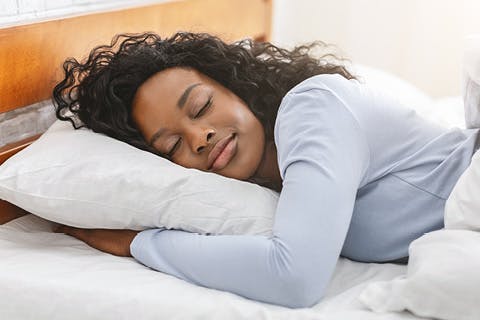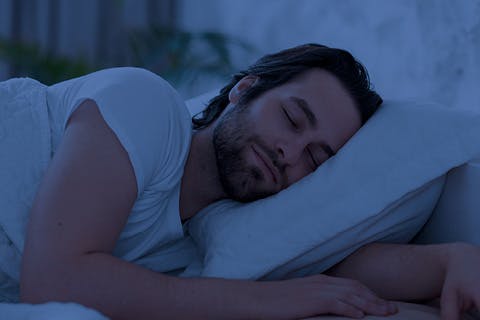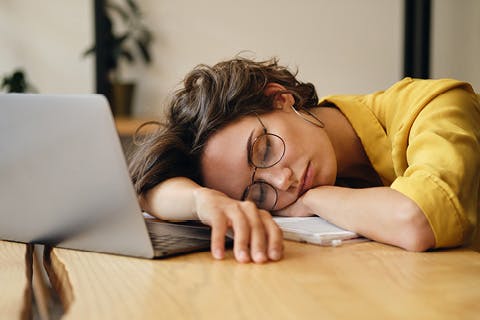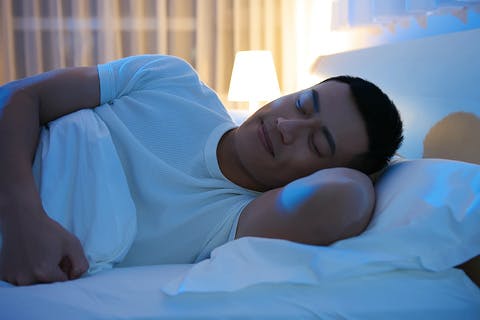Your Guide to Light Sleep

Light sleep is an important part of the body and brain’s recovery cycle, helping them to slowly relax and prepare for the later and deeper stages of sleep. If you’ve ever felt yourself twitch as you’re drifting off, that’s a factor of just one part of your light sleep stage.
Let’s take a look at what it is, and how you can make the most of this crucial stage.

What is light sleep?
You’ve probably heard of deep sleep and REM sleep, but did you know that a great deal of your night consists of light sleep? Making up the majority of your sleep cycle (50-60%), it plays a large and important role in your rest period.
The first stage of light sleep occurs after you drift off. It’s when your body starts to relax, to the extent you may even start to twitch and dream. It won’t last very long, around 1 to 7 minutes, and you’ll still be relatively alert and easy to wake.
After this, you’ll move into a steadier state of light sleep, where your heartbeat and breathing rate slows, your muscles relax, and your body temperature decreases. Your brain waves are also less active during this stage, slowing down but still peppered with brief bursts of activity.
These short bursts of brain waves are called ‘spindles’, and help us remember how to perform physical tasks, as well as clearing out unimportant information that isn’t needed. This works hand-in-hand with similar brain waves in deep sleep that are responsible for helping us retain facts, ideas, and concepts.

How much light sleep is normal?
You can’t exactly control how much light sleep you get, but there are factors within your control to ensure your light sleep is good quality. So just what percentage of light sleep is normal?
When you sleep, you go through a constant cycle of light sleep, deep sleep, and REM sleep, all of which lasts for around 90 minutes. As the cycle repeats, the ratio of each stage changes, but they follow the same pattern.
The average time an adult spends in light sleep is around 60% of this cycle, but as with all sleep, it varies from person to person.
As you age, the ratio of deep sleep decreases, with some people not experiencing any deep sleep at all. For the mature-aged, this is completely normal, however will still need around 7-8 hours sleep per night, so it’s important to make sure the sleep is good quality.
How can you maximise the quality of light sleep?
As you’re more aware of your surroundings in light sleep, make sure you:
- Sleep in a quiet room
- Block out light where possible
- Minimise distractions before sleep
Temperature can also play a role in sleep quality, so make sure you are comfortable; not too hot or cold.

How much light sleep do you need?
There is actually no recommended amount of light sleep; as this stage is the first and unavoidable stage during sleep. As a general rule of thumb, adults need between 7-9 hours of total sleep each night, but this can vary depending on the person. So if you’re wondering just how much light sleep you need, there’s no one-size-fits-all answer.
It’s not well understood why this amount changes from person to person, but if you want to know if you’re catching enough sleep in general, your performance and mood throughout the day could be telling:
- Do you find it hard to remember things?
- Are you easily irritated?
- Do you find it difficult to make decisions?
- Are you hungrier than normal?
All these things can be caused by lack of sleep, so they’re good signs to keep an eye out for.

Is light sleep still good?
While all stages of sleep are important and play different roles in our bodies, getting light sleep on its own is still beneficial.
To see the benefits of light sleep, you need look no further than the humble nap. A quick kip that lasts between 20 and 30 minutes is a great pick-me-up, as you’re less likely to enter a deep sleep and more likely to wake up refreshed, getting all the benefits of this part of your sleep cycle.
In fact, studies have found short naps improve cognitive performance, and could be a way to improve productivity at work.
Although we still have a lot to learn about light sleep, we do know just how crucial it is to have good-quality sleep. Being more alert during the light sleep stage, it’s important to ensure your sleep environment is set up for tranquillity and comfort.
Our in-store Profiler system will help you choose the mattress that best suits you, ensuring a better night’s sleep. Our Snooze consultants will fit you to the right mattress. Browse the Snooze range today.
References
https://www.sleepscore.com/blog/about-light-sleep/
https://www.healthline.com/health/how-much-deep-sleep-do-you-need#stages
https://www.sleepfoundation.org/sleep-hygiene/napping
https://www.sleepcycle.com/how-to-fall-asleep/what-does-normal-sleep-look-like/
https://www.nhlbi.nih.gov/health/sleep-deprivation/health-effects
https://www.sleephealth.org/sleep-health/importance-of-sleep-understanding-sleep-stages/
https://www.sleephealthjournal.org/article/S2352-7218%2815%2900015-7/fulltext
https://www.healthline.com/health/how-much-deep-sleep-do-you-need#deep-sleep
https://health.clevelandclinic.org/what-is-the-ideal-sleeping-temperature-for-my-bedroom/
https://www.healthline.com/health/how-much-deep-sleep-do-you-need#deep-sleep